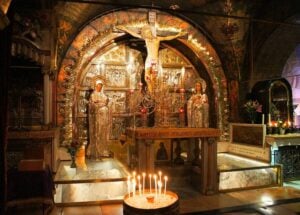“Could This Unearthed Garden in Jerusalem Rewrite the Story of Jesus’ Burial?”
Ever wonder what might be lurking beneath the ancient stone floors of the Church of the Holy Sepulchre in Jerusalem? Well, archaeologists have recently uncovered some truly remarkable findings that could literally connect us to biblical history in a way we never imagined! Excavations at this sacred site have revealed plant remains dating back over 2,000 years, possibly from the very garden mentioned in the Gospel of John, where Jesus was crucified and buried. It’s like stepping into a living history book—only instead of dusty pages, we’ve got ancient olive trees and grapevines whispering tales of a bygone era! As researchers peel back layers of time, they’re not just uncovering artifacts—they’re also digging into the rich spiritual legacy that this site has held for centuries. So, if you’re intrigued by these divine botanical revelations, stick around as we explore what this incredible discovery means for our understanding of faith and history. LEARN MORE.
Excavations at the Church of the Holy Sepulchre in Jerusalem have revealed 2,000-year-old plant remains that may be from the ancient garden mentioned in the biblical Gospel of John.

askii/Flickr The Church of the Holy Sepulchre, where Jesus is believed to have been buried.
In John 19:41, the Bible states that Jesus was crucified and buried near a garden just outside the city walls of Jerusalem. Now, archaeologists excavating the Church of the Holy Sepulchre believe they may have identified it.
Since 2022, researchers have had the rare privilege of studying one of Christianity’s most sacred sites. Beneath the church’s ancient stone floors, they have uncovered a wealth of artifacts, including pottery, coins, and other items dating from the Iron Age to the Crusades.
Recently, they uncovered the most significant finding yet: plant material from olive trees and grape vines dating back 2,000 years, around the time of Jesus’ death. The finding has provided support for biblical accounts of Jesus’ crucifixion and burial, offering a direct connection to the events described in Scripture.
The History Of The Church Of The Holy Sepulchre

Adam Cohn/Flickr The Church of the Holy Sepulchre’s interior dome.
Believed to be the site of Jesus’ crucifixion, the Church of the Holy Sepulchre in the Old City of Jerusalem welcomes millions of pilgrims every year.
Its influence as a holy place in Christianity dates as far back as the fourth century, when Roman Emperor Constantine the Great ordered a pagan temple on the site to be turned into a church. During the building’s construction, workers discovered an old tomb that they believed was that of Jesus Christ.
Since then, it’s been widely believed the church was built on the site of Jesus’ crucifixion and tomb. Today, it is one of the holiest places in all of Christianity.

Jlascar/Wikimedia CommonsThis structure surrounds what is purportedly the original tomb of Jesus in the Church of the Holy Sepulchre, where he was allegedly buried in the Shroud of Turin.
With its impressive historical background, the church has served as a focal point for archaeologists and historians. Since 2022, archaeologists, geologists, archaeobotanists, and archaeozoologists have been excavating the church and studying its artifacts, looking to piece together its long history.
In addition to traditional excavation methods, tools like 3D mapping and radar are helping researchers visualize the church’s layers and structures without disturbing the delicate site. These technologies can create detailed digital reconstructions of the building and its surroundings, essentially compiling a complete historical timeline.
“While we have not been able to see the entire church excavated in one glance, new technologies are allowing us to reconstruct the bigger picture in our labs,” Professor Francesca Romana Stasolla of the Sapienza University of Rome, the leader of the excavations, told the Times of Israel. “If we were talking about a puzzle, we could say we are only excavating one piece at a time, but eventually, we will have a complete multimedia reconstruction of the full picture.”
Recently, these excavations revealed an important finding beneath the stone floor of the church — one that lends further support to the biblical account of Jesus’ burial.
Archaeologists Uncover An Ancient Garden Under The Church’s Floor

Ondřej Žváček/Wikimedia CommonsThis altar marks the alleged spot where Jesus’ cross was raised during his crucifixion.
In 2022, researchers led by Stasolla were granted permission from the Orthodox Patriarchate, the Custody of the Holy Land, the Armenian Patriarchate, and the Israel Antiquities Authority to conduct excavations at the Church of the Holy Sepulchre.
During their work, archaeologists uncovered pottery, glass, oil lamps, stone walls, and even forgotten Crusade-era altars. However, perhaps the most significant finding was made only recently.
Researchers performed archaeobotanical analysis on soil taken from beneath the church’s stone floor and found seeds and pollen from olive trees and grape vines. While radiocarbon dating is still in process, these plant remains seemingly date back approximately 2,000 years, around the time of Jesus’ death.














